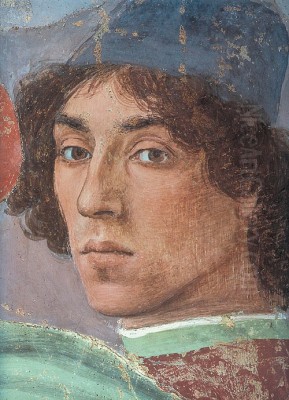
Filippino Lippi stands as a significant figure in the vibrant artistic landscape of late fifteenth-century Florence. Born into an artistic lineage yet marked by unconventional circumstances, he navigated the transition from the Early to the High Renaissance, forging a style that was both deeply personal and profoundly influential. His work, characterized by expressive intensity, intricate detail, and a restless energy, reveals an artist grappling with the legacy of his predecessors while pushing the boundaries of contemporary taste. As the son of a famous painter and the pupil of another, Filippino absorbed the lessons of the Quattrocento masters but ultimately charted his own unique course.
His life and career unfolded primarily in Florence, the epicenter of Renaissance art, but also included a crucial period in Rome that exposed him to the grandeur of antiquity. He excelled in both large-scale fresco cycles and intimate panel paintings, tackling religious narratives, devotional images, and mythological subjects with a distinctive flair. Often overshadowed in popular accounts by his teacher Botticelli or the giants of the High Renaissance, Filippino Lippi remains a fascinating artist whose complex, sometimes unsettling, beauty continues to captivate viewers and challenge art historians.
Early Life and Artistic Formation
Filippino Lippi was born around 1457 in Prato, near Florence, the fruit of a famously scandalous union. His father was the Carmelite friar and celebrated painter Fra Filippo Lippi, and his mother was Lucrezia Buti, a nun who had been placed under Fra Filippo's charge. This relationship, which resulted in Filippino's illegitimate birth, caused considerable controversy. Despite the irregular circumstances, Cosimo de' Medici's influence and eventually papal dispensation allowed Fra Filippo and Lucrezia to be released from their vows, though whether they formally married remains debated by historians. Filippino's birth status would remain a factor in his life.
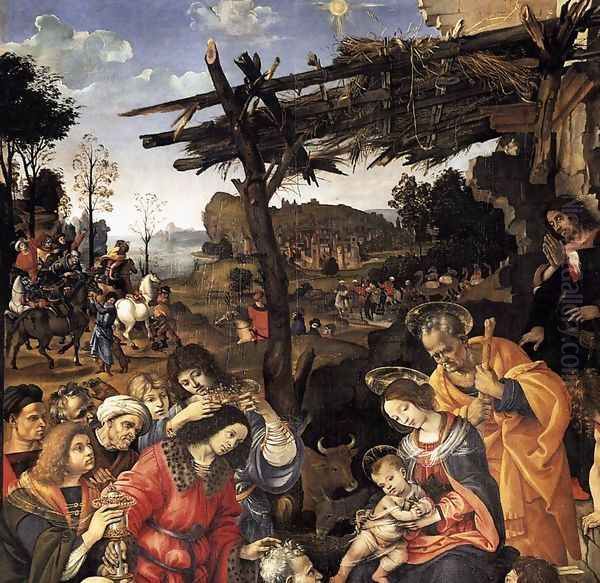
Tragically, Fra Filippo Lippi died in Spoleto in 1469, when Filippino was only about twelve years old. His initial artistic guidance likely came from Fra Diamante, his father's main assistant, who had accompanied the Lippi family. However, the most decisive phase of his training began around 1472 when he entered the workshop of Sandro Botticelli in Florence. Botticelli himself had likely spent time in Fra Filippo Lippi's workshop earlier, creating a direct link between father, son, and master.
Filippino remained with Botticelli for several years, likely completing his apprenticeship around 1473 or shortly thereafter, though their association continued. Botticelli's influence is palpable in Filippino's early works, particularly in the elegant linearity, the graceful, often melancholic figures, and the sophisticated composition. By the mid-1470s, Filippino was beginning to establish himself as an independent master, ready to undertake his own commissions and develop his individual artistic voice, though the echoes of both his father's robust naturalism and Botticelli's lyrical grace would continue to resonate in his art.
The Brancacci Chapel Commission
One of Filippino Lippi's most significant early undertakings was the completion of the fresco cycle in the Brancacci Chapel in the church of Santa Maria del Carmine, Florence. This was a commission of immense prestige and considerable challenge. The chapel housed frescoes begun over half a century earlier by the revolutionary Masaccio and his collaborator Masolino da Panicale, works that were foundational to the development of Renaissance painting. Their work had been left unfinished, likely due to Masaccio's early death and political shifts.
Around 1485, Filippino was tasked with completing the narrative cycle, focusing on scenes from the life of St. Peter. This required him not only to demonstrate his own considerable skill but also to harmonize his style with that of the revered earlier masters. He painted several key scenes, including the lower register sections like the Raising of the Son of Theophilus and St. Peter Enthroned, the Disputation with Simon Magus and the Crucifixion of St. Peter, St. Peter Visited in Prison by St. Paul, and St. Peter Being Freed from Prison.
Filippino rose to the occasion admirably. He successfully integrated his work with the existing frescoes, respecting the gravity and naturalism of Masaccio while infusing the scenes with his own burgeoning style, characterized by a greater fluidity of line, more animated figures, and a richer level of detail, particularly in architectural settings and contemporary portraiture woven into the narratives. The Brancacci Chapel commission solidified Filippino's reputation as one of Florence's leading young painters, capable of handling complex, large-scale projects.
Developing a Distinctive Style
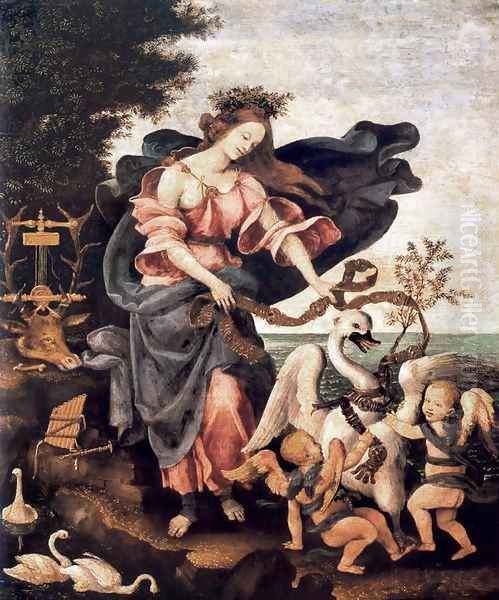
Moving beyond his apprenticeship and the direct influence of Botticelli, Filippino Lippi cultivated a highly individual artistic style during the 1480s and 1490s. While the linear elegance learned from Botticelli remained, Filippino's work often acquired a nervous energy, a heightened emotionalism, and a complexity that set it apart. His figures became more expressive, sometimes displaying agitated movement or intense psychological states. Compositions grew denser, filled with intricate details, elaborate costumes, and imaginative architectural backdrops.
His color palette could be rich and vibrant, but he also explored more somber tones, particularly later in his career. He demonstrated exceptional skill as a draughtsman, evident in the numerous surviving preparatory drawings which reveal his meticulous planning and fluid line. His technique involved refined brushwork in tempera and, increasingly, the use of oil glazes to achieve greater depth and luminosity. He was noted for his subtle use of pigments, including metal whites and greys, applied with delicate lines to render fine details and model form.
Key works from this period showcase his evolving style. The Vision of St. Bernard (c. 1486, Badia Fiorentina, Florence) combines spiritual intensity with delicate naturalism. Various Madonna and Child compositions, such as the Madonna and Child with Saints (also known as the Pala degli Otto, c. 1486, Uffizi, Florence) or the version housed in the Pitti Palace (c. 1485), display his ability to convey tender emotion within sophisticated arrangements. The Adoration of the Magi (1496, Uffizi, Florence), commissioned by the monks of San Donato a Scopeto (replacing an earlier commission from Leonardo da Vinci), is a complex, dynamic composition filled with exotic figures and intricate details, demonstrating his mature, independent manner.
Roman Sojourn and the Carafa Chapel
Between approximately 1488 and 1493, Filippino Lippi spent a significant period working in Rome. This experience was crucial for his artistic development, exposing him directly to the remnants of classical antiquity and the burgeoning artistic activity under papal patronage. His most important commission during this time was the decoration of the Carafa Chapel in the church of Santa Maria sopra Minerva, undertaken for the influential Cardinal Oliviero Carafa.
The frescoes in the Carafa Chapel depict scenes from the life of St. Thomas Aquinas, the Cardinal's namesake saint and a pillar of Dominican theology, along with a grand Assumption of the Virgin above the altar and an Annunciation. Here, Filippino's style absorbed new influences. His compositions became even more elaborate, incorporating detailed renderings of ancient Roman architecture, reliefs, and artifacts. This archaeological interest added a layer of learned complexity to his work.

The Roman environment, with its monumental ruins and the presence of other artists like Melozzo da Forlì and Pinturicchio, seems to have encouraged a greater sense of drama and grandeur in Filippino's art. The figures in the Carafa Chapel frescoes possess a heightened rhetorical energy, and the overall effect is one of dynamic narrative and intellectual richness. This Roman period marked a significant evolution, adding a more robust, classically informed dimension to his Florentine training.
The Strozzi Chapel: A Late Masterpiece
Upon his return to Florence, Filippino Lippi embarked on what is considered one of his greatest achievements: the fresco cycle in the Strozzi Chapel in Santa Maria Novella. Commissioned by the wealthy banker Filippo Strozzi the Elder (though largely executed after the patron's death), the work began perhaps as early as 1487 but was primarily carried out and completed between the late 1490s and 1502. The chapel is dedicated to St. Philip the Apostle and St. John the Evangelist.
These frescoes represent Filippino's late style at its most dramatic and imaginative. The main scenes, St. Philip Driving the Dragon from the Temple of Hieropolis and St. John the Evangelist Resuscitating Drusiana, are tumultuous compositions, crowded with figures in agitated movement and expressive, sometimes contorted, poses. The architectural settings are fantastical constructions, blending classical elements with imaginative inventions. The emotional intensity is palpable, bordering on the visionary or even the bizarre.
The Strozzi Chapel frescoes showcase Filippino's fascination with antiquity, but it is an antiquity filtered through his own restless imagination. The level of detail, the dramatic use of light and shadow, and the sheer energy of the scenes are remarkable. Compared to the more ordered and serene classicism of contemporaries like Domenico Ghirlandaio, Filippino's late work appears almost proto-Mannerist in its expressive freedom and rejection of simple harmony. It is a powerful testament to his unique artistic vision in the final years of his life.
Other Notable Works and Themes
Beyond his major fresco cycles, Filippino Lippi was a prolific painter of panel paintings, primarily religious subjects but also occasional mythological or allegorical themes. Madonnas were a recurring subject throughout his career, ranging from early works clearly indebted to Botticelli to later, more emotionally complex interpretations like the Madonna and Child (c. 1483-84, Metropolitan Museum of Art, New York). He painted several versions of the Madonna and Child with the Infant St. John, a popular Florentine theme, often imbuing the scene with a tender melancholy.
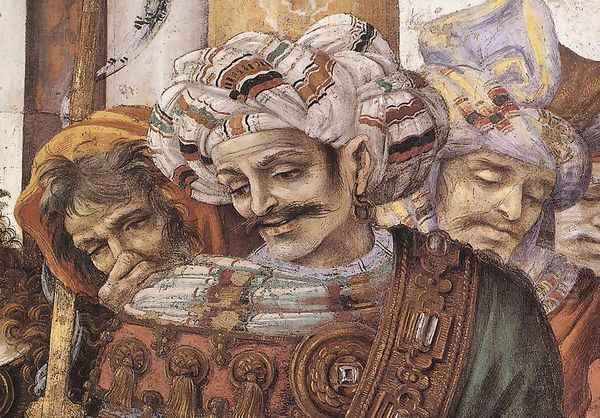
Works like The Holy Family with the Infant St. John and St. Margaret (c. 1495, Cleveland Museum of Art) demonstrate his skill in composing multi-figure groups within intimate settings. Although less common, he also tackled allegorical subjects, such as the debated Allegory of Music (Erato) at the Gemäldegalerie, Berlin. Portraiture was another aspect of his work, though often integrated into larger narrative scenes, such as the numerous contemporary Florentine figures depicted in the Brancacci and Strozzi Chapel frescoes.
Filippino was also a highly accomplished draughtsman. Numerous preparatory drawings survive, executed in metalpoint, pen and ink, and chalk. These studies reveal his working methods, his exploration of poses and compositions, and the sheer fluidity and confidence of his line. They are artworks in their own right, offering insights into the mind of a restless and inventive artist. His patrons included major Florentine families like the Strozzi and Del Pugliese, as well as religious orders and confraternities.
Relationships with Contemporaries
Filippino Lippi's career unfolded within the intensely competitive and collaborative artistic milieu of late Quattrocento Florence and Rome. His relationship with his teacher, Sandro Botticelli, was foundational. While Filippino absorbed much from Botticelli, particularly linear grace and compositional strategies, he developed a distinct artistic personality, often favouring more dynamic movement and overt emotionalism, especially in his later works. Some critics even feel his late works surpassed Botticelli in certain aspects of dramatic invention.
His artistic lineage connected him directly to his father, Fra Filippo Lippi, whose robust figure style and interest in naturalistic detail can be seen as an underlying influence. He interacted with the leading artists of his time. He would have known the work of Andrea del Verrocchio, a dominant figure whose workshop trained Leonardo da Vinci and Lorenzo di Credi. While Filippino wasn't a direct pupil of Verrocchio, the latter's influence permeated Florentine art.
He worked alongside artists like Perugino, Ghirlandaio, and Cosimo Rosselli in decorating Lorenzo de' Medici's villa at Spedaletto (now lost), showcasing the collaborative nature of large projects. He certainly knew the work of Leonardo da Vinci, whose innovations in sfumato and psychological depth were transforming Florentine painting, though Filippino pursued a different path emphasizing line and expressive energy. He was also contemporary with artists like Piero di Cosimo, known for his own eccentricities, and perhaps shared a certain imaginative kinship. The influence of earlier masters like Donatello and Fra Angelico can also be discerned in his approach to form and religious sentiment.
Technique and Workshop
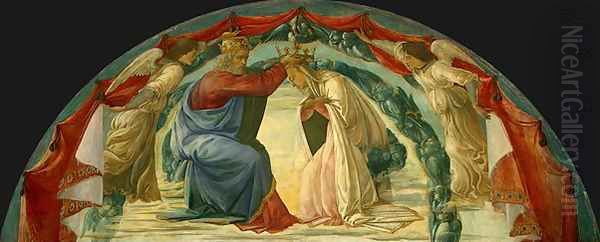
Filippino Lippi was a master technician, proficient in the primary media of his time. He excelled in fresco painting, demonstrating a remarkable ability to handle large-scale compositions and maintain coherence and detail across vast wall surfaces, as seen in the Brancacci, Carafa, and Strozzi Chapels. His panel paintings were typically executed in tempera, often on poplar wood, using meticulous layering of pigments bound with egg yolk to achieve rich colors and precise details. He also increasingly incorporated oil painting techniques, allowing for greater subtlety in blending tones and achieving luminous effects, particularly in his later works.
Drawing was fundamental to his practice. His preparatory studies, often in metalpoint on prepared paper or pen and ink, show his careful planning of figures and compositions. His line is typically fluid, confident, and expressive. The source material mentions his skill in using metal white and grey-white pigments with subtle lines, likely referring to highlights applied with fine brushes in tempera or detailed work in drawings. He was adept at using light and shadow (chiaroscuro) to model forms, create spatial depth, and enhance the dramatic impact of his scenes.
Like most successful artists of the period, Filippino maintained an active workshop to assist him with commissions. The presence of assistants is common in large fresco cycles and even in some panel paintings. This inevitably leads to questions of attribution regarding certain works or passages within works. While specific names are scarce, Raffaellino del Garbo is often mentioned as an artist who worked closely with Filippino or was strongly influenced by him, possibly spending time in his workshop. The workshop system allowed masters like Filippino to manage multiple projects and train the next generation of artists.
Anecdotes, Character, and Controversies
Filippino Lippi's life, beginning with his parents' scandalous relationship and his own illegitimate birth, set him apart from the start. While the direct impact on his career is hard to measure, it may have contributed to a certain sensitivity or outsider perspective reflected in the emotional intensity of his art. Art historian Giorgio Vasari, in his Lives of the Artists, provides the earliest biographical account. Vasari praised Filippino's talent, particularly his skill in ornamentation, costumes, and his incorporation of classical 'grotesques' (ancient Roman decorative motifs). However, Vasari also mildly criticized him for being perhaps too inventive and striving excessively for novelty, particularly in the Strozzi Chapel.
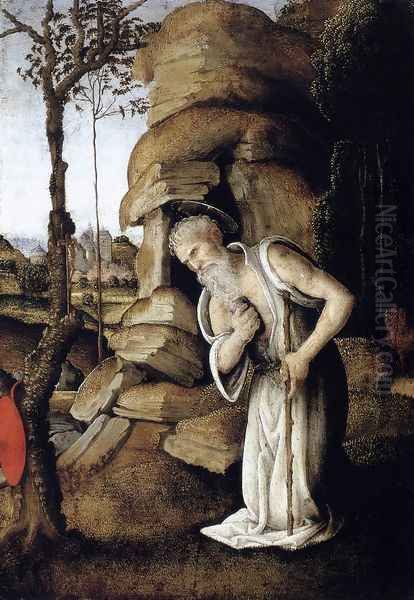
The interpretation of certain elements in Filippino's work has remained a point of discussion. His late style, with its agitated figures, complex compositions, and sometimes unsettling details (like the dragon in the Strozzi Chapel), has been described as eccentric or capricious. Some scholars, like Bernard Berenson, saw him as a forerunner of Mannerism, an artist who prioritized expressive effect over classical harmony. Others see these elements as part of his unique exploration of emotional and psychological states.
Attribution issues continue to surround his oeuvre. Distinguishing the master's hand from that of workshop assistants can be challenging, leading to ongoing scholarly debate about specific paintings or drawings. The source text's confusion regarding a Madonna and Child with Saints and Angels dated 1450-1500 and attributed variously to Francesco Francia or the Master of San Miniato highlights the complexities, though this specific dating seems incompatible with Filippino's lifespan for a work solely by him. Filippino's life was cut short; Vasari reports he died in 1504 from a severe attack of angina or throat inflammation (possibly strep throat or diphtheria) at the relatively young age of 47. His death was reportedly mourned greatly in Florence, and public workshops closed on the day of his burial.
Legacy and Influence
Despite any contemporary criticisms of eccentricity, Filippino Lippi was highly esteemed during his lifetime and recognized as one of Florence's leading masters. His ability to complete the Brancacci Chapel frescoes and secure major commissions like the Carafa and Strozzi Chapels attests to his high standing. His immediate influence can be seen in the work of artists associated with his workshop, like Raffaellino del Garbo.
More broadly, Filippino's art played a significant role in the transition towards the High Renaissance and, perhaps more importantly, prefigured aspects of Mannerism. His emphasis on expressive intensity, complex and sometimes ambiguous spatial arrangements, elongated figures, and imaginative incorporation of antique motifs provided a departure point for later artists seeking alternatives to the calm classicism of the High Renaissance masters like Raphael. Artists such as Pontormo and Rosso Fiorentino, key figures of early Florentine Mannerism, pushed the expressive and anti-classical tendencies seen in Filippino's late work even further.

While his fame may have been eclipsed at times by his teacher Botticelli or the subsequent generation of Leonardo, Michelangelo, and Raphael, Filippino Lippi's reputation has been firmly re-established by modern art history. He is recognized for his technical brilliance, his unique synthesis of inherited traditions (from Fra Filippo Lippi and Botticelli) and personal innovation, and his contribution to the emotional and decorative richness of Florentine painting. His work offers a fascinating glimpse into the artistic ferment of the late fifteenth century, standing as a bridge between the confident explorations of the Early Renaissance and the complex artistic currents that followed.
Conclusion
Filippino Lippi remains a compelling figure in the history of Italian Renaissance art. Born into the heart of the Florentine artistic world, he navigated a complex personal background and the towering legacies of his father and his teacher, Sandro Botticelli, to forge a powerful and distinctive style. From the sensitive naturalism of his early Madonnas and his respectful completion of the Brancacci Chapel to the dramatic intensity and imaginative complexity of his Roman works and the Strozzi Chapel frescoes, his art reveals a continuous evolution and a restless creative spirit.
His mastery of line, his sophisticated use of color and light, and his ability to convey deep emotion mark him as a major talent. While sometimes characterized by a nervous energy or a penchant for the ornate and fantastic that set him apart from the High Renaissance ideals of harmony and balance being formulated by Leonardo, Michelangelo, and Raphael, it is precisely these qualities that make his work so intriguing. Filippino Lippi offers a unique window onto the artistic possibilities and anxieties of a period of profound transition, leaving behind a body of work that continues to engage and reward close looking.